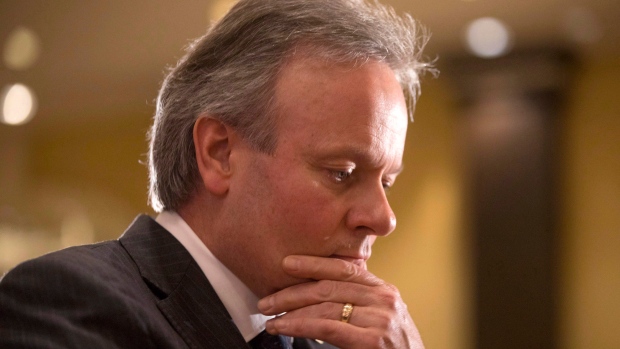The Bank of Canada is set to release its latest decision at 10 a.m. ET Wednesday in Ottawa, and there are three plausible outcomes:
- The most probable is policy makers will raise the overnight interest rate, currently at 1.25 per cent, for a fourth time in 12 months to keep inflation under wraps, while acknowledging future hikes will be gradual because of the recent trade upheaval. Markets are placing the highest odds on this scenario, which includes additional hikes every six months or so until the benchmark rate settles around 2 per cent or 2.25 per cent by the end of 2019.
- A second possibility is an increase that is accompanied by very cautious language that casts doubt on the timing and pace of future moves, a scenario known in central banking lingo as a dovish hike. Essentially, that would mean a rate hike now at the expense of one down the line.
- A third option has Governor Stephen Poloz abstaining altogether. In this case, he would almost certainly indicate rates are heading quickly higher, a so-called hawkish hold.
Poloz faces a delicate task. With inflation already above the central bank’s 2 per cent target and heading higher, and with financial conditions still very loose, he needs to keep wage and price pressures in check. At the same time, moving too soon and too fast could inadvertently trigger a downturn, in part by inflating the Canadian currency, at a time when the economy is awash in risk.
The three scenarios have one thing in common: the certainty that rates are going higher, and probably sooner rather than later.
The Case for Hiking
Poloz said last month the Bank of Canada has become “particularly” data dependent, and the most recent numbers point to a hike. Inflation is marching higher and may approach 3 per cent. Second-quarter gross domestic product looks set to exceed 2 per cent, faster than the country’s long-term sustainable growth rate. At the same time, there’s little, if any, spare capacity in the economy.
Additionally, wages are accelerating and executives are warning about labor shortages. Exports and investment -- the twin pillars of disappointment over the past decade -- are finally beginning to show signs of health.
What’s more, the overnight rate is still 75 basis points below the inflation target. Getting the so-called real rate of interest back to zero is the new yardstick of normalization for Poloz, who says there’s no good reason why borrowing costs should remain in negative territory.
Plus, the central bank has already built some cushion for trade uncertainty into its benchmark rate. In other words, borrowing costs would be higher were Donald Trump not threatening new tariffs.
The Case for Holding
Poloz has put uncertainty at the forefront of his recent policy making and uncertainties -- at least on trade -- have clearly risen since the last rate decision in May.
Since then, Trump has imposed new steel tariffs on Canada and squared off with Prime Minister Justin Trudeau on trade policy. The Bank of Canada could argue that all of this makes it more difficult to project an inflation outlook and predict the appropriate path for interest rates, and therefore caution is warranted. It could also reiterate its conviction that the recent inflation spike will be temporary.
National Bank of Canada predicts Poloz will hold rates steady. Stefane Marion, chief economist at the Montreal-based lender, said in a July 3 BNNBloomberg interview that this is “one of the rare instances where you can argue that given this uncertainty out there why would you proceed with a rate hike if things turn from bad to worse later this summer.”
Yet, Poloz had an opportunity to address the growing trade tensions at a June 27 press conference but he chose instead to downplay the issue. National is alone among Canada’s largest banks in calling for a hold. The other five all expect rates to rise on Wednesday.










